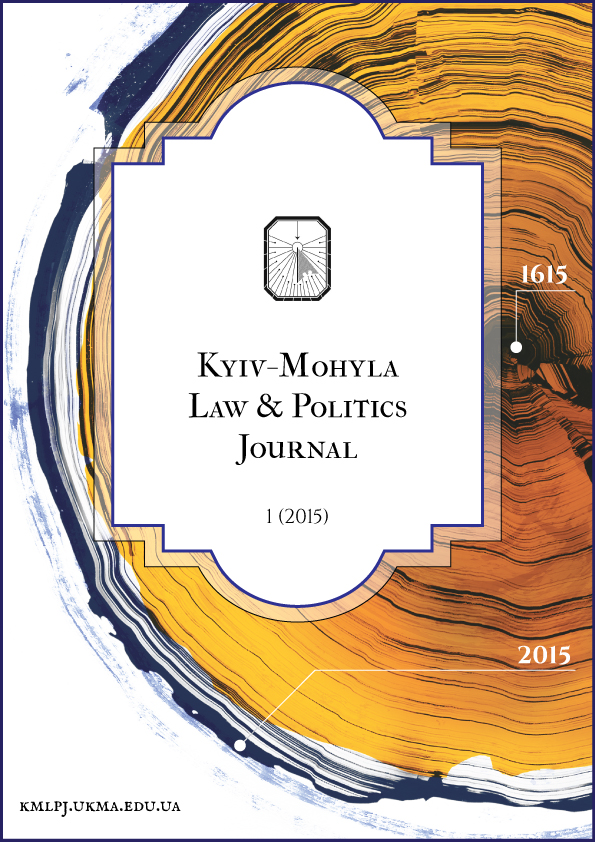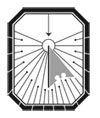The Winter of Our Discontent: Emotions and Contentious Politics in Ukraine during Euromaidan
DOI:
https://doi.org/10.18523/kmlpj52673.2015-1.39-62Keywords:
social movements, moral shock, Euromaidan, mobilization, collective identity, emotionsAbstract
Drawing upon 60 semi-structured interviews, this study adopts an emotion-centered approach to studying the non-violent phase of Euromaidan protests in Ukraine. We find that, first, the overlapping and mutual amplifying of two successive moral shocks was the primary mechanism of mobilization. The mobilizing success of the moral shocks is interpreted through introducing the notion of emotional path dependence. Second, the nature of moral shock is explained as a combination of emotional and cognitive components. Third, we find that emotional components of collective identity construction created moral barriers between a brotherhood of virtuous protesters and profoundly immoral antagonists, which, combined with the perceived universality of claims, rendered the bystanders’ position unacceptable.References
- Adams, Jacqueline. “The Bitter End: Emotions at a Movement’s Conclusion.” Sociological Inquiry 73.1 (2003): 84–113. https://doi.org/10.1111/1475-682x.00042
- Aminzade, Ron, and Doug McAdam. “Emotions and Contentious Politics.” In Silence and Voice in the Study of Contentious Politics, edited by Ron Aminzade et al., 14–50. Cambridge: Cambridge University Press, 2001. https://doi.org/10.1017/cbo9780511815331.003
- Blumer, Herbert. “Collective Behavior.” In Principles of Sociology, edited by Alfred McClung Lee, 65–121. New York: Barnes and Noble, 1969.
- Cohen, Jean. “Strategy or Identity: New Theoretical Paradigms and Contemporary Social Movements.” Social Research 52.4 (1985): 663–716.
- Collins, Randall. “Social Movements and the Focus of Emotional Attention.” In Passionate Politics: Emotions and Social Movements, edited by Jeff Goodwin, James M. Jasper, and Francesca Polletta, 27–44. Chicago, Ill.: University of Chicago Press, 2001. https://doi.org/10.7208/chicago/9780226304007.003.0002
- de Volo, Lorraine Bayard. “The Dynamics of Emotion and Activism: Grief, Gender, and Collective Identity in Revolutionary Nicaragua.” Mobilization 11.4 (2006): 461–74.
- Emirbayer, Mustafa and Goldberg, Chad A. “Pragmatism, Bourdieu, and Collective Emotions in Contentious Politics.” Theory and Society 34 (2005): 469–518. https://doi.org/10.1007/s11186-005-1619-x
- Eyerman, Ron. “How Social Movements Move: Emotions and Social Movements.” In Emotions and Social Movements, edited by Helena Flam and Debra King, 41–56. Abingdon: Routledge, 2005. https://doi.org/10.4337/9781781954706.00022
- Ferree, Myra Marx and Miller, Frederick D. “Mobilization and Meaning: Toward an Integration of Social Psychological and Resource Mobilization Perspectives on Social Movements.” Sociological Inquiry 55.1 (1985): 38–51. https://doi.org/10.1111/j.1475-682x.1985.tb00850.x
- Flam, Helena. “Emotional Man. Part 1: The Emotional Man and the Problem of Collective Action.” International Sociology 5.1 (1990): 39–56.
- Gamson, William A. The Strategy of Social Protest. Homewood, IL: Dorsey Press, 1975. https://doi.org/10.1177/026858090005001004
- Gamson, William A. “Constructing Social Protest.” In Social Movements and Culture, edited by Hank Johnston and Bert Klandermans, 85–106. Minneapolis: University of Minnesota Press, 1995.
- Goodwin, Jeff, James M. Jasper, and Francesca Polletta. “The Return of the Repressed: The Fall and Rise of Emotions in Social Movement Theory.” Mobilization 5.1 (2000): 65–83.
- Goodwin, Jeff. “The Libidinal Constitution of a High-Risk Social Movement: Affectual Ties and Solidarity in the Huk Rebellion, 1946 to 1954.” American Sociological Review 62.1 (1997): 53–69. https://doi.org/10.2307/2657452
- Gould, Deborah. “Passionate Political Processes: Bringing Emotions Back into the Study of Social Movements.” In Rethinking Social Movements, edited by Jeff Goodwin and James M. Jasper, 155–75. Lanham, MD: Rowman and Littlefield, 2003.
- Gould, Robert V. “Multiple Networks and Mobilization in the Paris Commune.” American Sociological Review 56.6 (1991): 716–29. https://doi.org/10.2307/2096251
- Hess, David and Martin, Brian. “Repression, Backfire, and the Theory of Transformative Events.” Mobilization 11.2 (2006): 249–67.
- Hoffer, Eric. The True Believer. New York: Frederic A. Praeger, 1962.
- Ishchenko, Volodymyr. Protesty, peremohy i represii v Ukraini: resultaty monitorynhu 2011 [Protests, Victories, and Repressions: Monitoring Results of 2011]. Kyiv: Tsentr doslidzhennia suspilstva, 2012.
- Jasper, James M. and Poulsen, Jane. “Recruiting Strangers and Friends: Moral Shocks and Social Networks in Animal Rights and Anti-Nuclear Protests.” Social Problems 42.4 (1995): 493–512. https://doi.org/10.2307/3097043
- Jasper, James M. The Art of Moral Protest: Culture, Biography, and Creativity in Social Movements. Chicago: University of Chicago Press, 1997. https://doi.org/10.1093/sf/77.4.1673
- Jasper, James M. “The Emotions of Protest: Affective and Reactive Emotions in and around Social Movements.” Sociological Forum 13.3 (1998): 397–424.
- Jasper, James M. “Motivation and Emotion.” In Oxford Handbook of Contextual Political Analysis, edited by Robert Goodin and Charles Tilly, 157–72. New York: Oxford University Press, 2006. https://doi.org/10.1007/s11615-007-0095-5
- Jasper, James M. “Cultural Approaches in the Sociology of Social Movements.” In Handbook of Social Movements across Disciplines, edited by Bert Klandermans and Conny Roggeband, 59–110. New York: Springer, 2007. https://doi.org/10.1007/978-0-387-70960-4_1
- Jasper, James M. “Emotions and Social Movements: Twenty Years of Theory and Research.” Annual Review of Sociology 37 (2011): 285–303. https://doi.org/10.1146/annurev-soc-081309-150015
- Kemper, Theodore D. A Social Interactional Theory of Emotions. New York: Wiley, 1978. https://doi.org/10.7208/chicago/9780226304007.003.0004
- Kemper, Theodore D. “A Structural Approach to Social Movement Emotions.” In Passionate Politics: Emotions and Social Movements, edited by Jeff Goodwin, James M. Jasper, and Francesca Polletta, 58–73. Chicago, Ill.: University of Chicago Press, 2001.
- Kim, Hyojoung. “Shame, Anger, and Love in Collective Action: Emotional Consequences of Suicide Protest in South Korea, 1991.” Mobilization 7.2 (2002): 159–76.
- Le Bon, Gustave. Psychologie des foules. Paris: Édition Félix Alcan, 1905.
- Lofland, John. “Charting Degrees of Movement Culture: Tasks of the Cultural Cartographer.” In Social Movements and Culture, edited by Hank Johnston and Bert Klandermans, 188–216. Minneapolis: University of Minnesota Press, 1995.
- McAdam, Doug. “Culture and Social Movements.” In New Social Movements: From Ideology to Identity, edited by Enrique Laraña, Hank Johnston and Joseph R. Gusfield, 36–57. Philadelphia: Temple University Press, 1994. https://doi.org/10.1093/sf/73.4.1633
- McAdam, Doug and Paulsen, Ronnelle. “Specifying the Relationship between Social Ties and Activism.” American Journal of Sociology 99.3 (1993): 640–67. https://doi.org/10.1086/230319
- McAdam, Doug, Sindey G. Tarrow, and Charles Tilly. Dynamics of Contention. Cambridge: Cambridge University Press, 2004. https://doi.org/10.1177/000169930204500407
- McCarthy, John D. and Zald, Mayer N. “Resource Mobilization and Social Movements: A Partial Theory.” American Journal of Sociology 82.6 (1977): 1212–41. https://doi.org/10.1086/226464
- McCauley, Clark and Sophia Moskalenko. “Mechanisms of Political Radicalization: Pathways Toward Terrorism.” Terrorism and Political Violence 20.3 (2008): 415–33. https://doi.org/10.1080/09546550802073367
- Melucci, Alberto. “The Process of Collective Identity in Social Movements and Culture.” In Social Movements and Culture, edited by Hank Johnston and Bert Klandermans, 41–64. Minneapolis: University of Minnesota Press, 1995. https://doi.org/10.1177/000169939704000115
- Morris, Aldon. The Origins of the Civil Rights Movement. New York: Free Press, 1984.
- Nepstad, Sharon Erickson and Smith, Christian S. “The Social Structure of Moral Outrage in Recruitment to the U.S. Central America Peace Movement.” In Passionate Politics: Emotions and Social Movements, edited by Jeff Goodwin, James M. Jasper, and Francesca Polletta, 158–74. Chicago: University of Chicago Press, 2001. https://doi.org/10.7208/chicago/9780226304007.003.0010
- Oberschall, Anthony. Social Conflict and Social Movements. Englewood Cliffs, NJ: Prentice Hall, 1973. https://doi.org/10.1093/sf/52.4.578
- Snow, David A. and McAdam, Doug. “Identity Work Processes in the Context of Social Movements: Clarifying the Identity/Movement Nexus.” In Self, Identity and Social Movements, edited by Sheldon Stryker, Timothy J. Owens, and Robert W. White, 41–67. Minneapolis: University of Minnesota Press, 2000. https://doi.org/10.5749/minnesota/9780816686513.003.0015
- Staggenborg, Suzanne. “The ‘Meso’ in Social Movement Research.” In Social Movements: Identity, Culture, and the State, edited by David S. Meyer, Nancy Whittier, and Belinda Robnett, 124–40. New York: Oxford University Press, 2002. https://doi.org/10.1086/380524
- Sushko, Oleksandr. “Vilniuskyi Rubikon: Kinets ‘Zolotoho Viku’ Yanukovycha.” [“Rubicon at Vilnius: The End of Yanukovych’s ‘Golden Age’.”] Accessed February 10, 2014. http://blogs.korrespondent.net/celebrities/blog/sasha5/a124360.
- Tarrow, Sidney G. “Old Movements in New Cycles of Protest: The Career of an Italian Religious Community.” International Social Movement Research 1 (1988): 281–304.
- Tarrow, Sidney G. “Cycles of Collective Action: Between Moments of Madness and the Repertoire of Contention.” Social Science History 17.2 (1993): 281–307. https://doi.org/10.2307/1171283
- Tarrow, Sidney G. Power in Movement. Cambridge: Cambridge University Press, 2011.
- Tilly, Charles. Contention and Democracy in Europe, 1650–2000. New York: Cambridge University Press, 2004. https://doi.org/10.1086/ahr/109.5.1529
- The Ilko Kucheriv Democratic Initiatives Foundation. “Maidan-2013: Khto stoit, chomu i za shcho?” [“Maidan-2013: Who is Standing, Why, and for What?”] Accessed March 19, 2014. http://www.dif.org.ua/ua/polls/2013-year/mogjorjghoeoj.htm.
- The Ilko Kucheriv Democratic Initiatives Foundation. “Maidan-Mitynh i Maidan-Tabir: Skhozhe i vidminne.” [“Maidan as a Mass-Rally and Maidan as a Camp: Similarities and Distinctions.”] Accessed March 19, 2014. http://www.dif.org.ua/ua/polls/2013-year/vjweojgvowerjoujgo.htm.
- Touraine, Alain. La Voix et le Regard. Paris: Éditions du Seuil, 1978. https://doi.org/10.3726/978-3-0351-0798-2/27
- Van Zomeren et al. “Put Your Money Where Your Mouth Is! Explaining Collective Action Tendencies through Group-based Anger and Group Efficacy.” Journal of Personality and Social Psychology 87.5 (2004): 649–64. https://doi.org/10.1037/0022-3514.87.5.649
- Walsh, Edward J. “Resource Mobilization and Citizen Protest in Communities around Three Mile Island.” Social Problems 29.1 (1981): 1–21. https://doi.org/10.1525/sp.1981.29.1.03a00010
- Whittier, Nancy. “Meaning and Structure in Social Movements.” In Social Movements: Identity, Culture, and the State, edited by David S. Meyer, Nancy Whittier, and Belinda Robnett, 289–307. New York: Oxford University Press, 2002. https://doi.org/10.1086/380524
- Wood, Elisabeth Jean. “The Emotional Benefits of Insurgency in El Salvador.” In Passionate Politics: Emotions and Social Movements, edited by Jeff Goodwin, James M. Jasper, and Francesca Polletta, 267–81. Chicago, Ill.: University of Chicago Press, 2001. https://doi.org/10.7208/chicago/9780226304007.003.0016
- Yang, Guobin. “Emotional Events and the Transformation of Collective Action.” In Emotions and Social Movements, edited by Helena Flam and Debra King, 79–98. Abingdon: Routledge, 2005.
- Yakovlev, Maksym. “Maidan i antimaidan v sotsialnykh setiakh: Kharakteristiki interpretatsionnykh ramok.” [“Maidan and Antimaidan in Social Networks: Some Features of Interpretational Frames.”] Forum noveishei vostochnoevropeiskoi istorii i kultury 10.2 (2013): 74–83.
- Zolberg, Aristide R. “Moments of Madness.” Politics and Society 2 (1972): 183–207.
Downloads
How to Cite
Issue
Section
License
Copyright (c) 2016 Ivan Gomza, Nadiia Koval

This work is licensed under a Creative Commons Attribution 4.0 International License.
Kyiv-Mohyla Law and Politics Journal provides free access to original research without restriction barriers (i.e. subscription fees, licensing fees etc.).
Unless otherwise indicated, content is licensed under the Creative Commons Attribution 4.0 International (CC BY 4.0) license, which means you are free to:
distribute, remix, tweak, and build upon your work, even commercially
...provided that any use is made with attribution to author(s) and Kyiv-Mohyla Law and Politics Journal.
The copyright in the article or any other submission to Kyiv-Mohyla Law and Politics Journal shall remain with the author(s).
The journal allows the author(s) to hold the copyright without restrictions and will retain publishing rights without restrictions.





